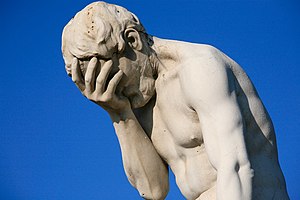Facepalm: Difference between revisions
→Internet usage: grammar |
|||
| Line 21: | Line 21: | ||
[[File:Smiley emoticons doh.gif|thumb|right|210px|An emoji is sometimes used to denote facepalm in online contexts]] |
[[File:Smiley emoticons doh.gif|thumb|right|210px|An emoji is sometimes used to denote facepalm in online contexts]] |
||
Facepalm's meaning online is the same as the physical gesture's meaning in real life, it expresses frustration, disappointment, embarrassment, shock, surprise or sarcasm. |
Facepalm's meaning online is the same as the physical gesture's meaning in real life, it expresses frustration, disappointment, embarrassment, shock, surprise or sarcasm. Its online use is to portray emotions and feelings that otherwise may not be easily expressed through text alone. Facepalm is understood online because of its common usage in the real world. The facepalm gesture is a popular internet [[meme]] to show a user's frustration or disappoint in an article, comment, or post from another user. |
||
The gesture can be visually represented by a picture of a person doing the gesture, or it can be shown through a recreation of someone doing the gesture using symbols, such as [[periods]], [[parentheses]], or [[brackets]], to form an outline of a person doing the physical gesture. The symbol representation of facepalm can be made in many different sizes for different purposes, such as a comment or a text message. Another visual use of facepalm is a facepalm [[emoji]] or [[emoticon]] that can be found on many websites such as [[Skype]]. These emoji are used in a similar sense to other internet uses of facepalm. |
The gesture can be visually represented by a picture of a person doing the gesture, or it can be shown through a recreation of someone doing the gesture using symbols, such as [[periods]], [[parentheses]], or [[brackets]], to form an outline of a person doing the physical gesture. The symbol representation of facepalm can be made in many different sizes for different purposes, such as a comment or a text message. Another visual use of facepalm is a facepalm [[emoji]] or [[emoticon]] that can be found on many websites such as [[Skype]]. These emoji are used in a similar sense to other internet uses of facepalm. |
||
Revision as of 14:46, 21 May 2014

A facepalm (sometimes also face-palm or face palm) is the physical gesture of placing one's hand flat across one's face or lowering one's face into one's hand or hands. The gesture is often exaggerated by giving the motion more force and making a slapping noise when the hand comes in contact with the face. The gesture is found in many cultures as a display of frustration, disappointment, embarrassment,[1] shock, surprise or sarcasm.[2]
Origins

According to Macmillan Dictionary, the word "facepalm" first appeared around 2006,[1] though another source has an earliest citation of 2001.[3] The gesture itself is not of recent origin and, although common, is not culturally universal.[2] Images of stockbrokers facepalming have also been widely used in the media to convey the dismay associated with poor financial performance,[2][4] and a wide variety of regrettable film,[5] business,[6] and political[7][8] decisions have been described as facepalms or "facepalm moments". According to Oxford University Press lexicographer Susie Dent, this versatility is one of the reasons that the word has been linguistically "successful".[9] This word was added to the English Oxford Dictionary in August 2011,[10] marking it as a legitimate word in the English language.
This gesture is not unique to humans. A group of mandrills at the Colchester Zoo has adopted a similar gesture to signal the desire to avoid social interaction or to be left alone.[11]
Popular culture
- Perhaps the most famous example of Facepalm is seen in the series Star Trek: The Next Generation, where an image of Jean-Luc Picard expresses frustration using this gesture and became famous,[12] making it into an internet meme.
- Facepalm was added to the popular Urban Dictionary in 2004.[13] Since then it has gained widespread popularity as a meme or comment image to portray the users frustration or disappointment of a certain topic.
- In South Park: The Stick of Truth, this gesture is used to denote the censorship of material, while also ridiculing countries' overly stringent censorship laws.[14]
- A list of facepalm uses in media can be found in its own entry in the TV Tropes website [15] where its usage has been recorded in all forms of media including television, movies, video games, and real world examples.
Internet usage
Facepalm's meaning online is the same as the physical gesture's meaning in real life, it expresses frustration, disappointment, embarrassment, shock, surprise or sarcasm. Its online use is to portray emotions and feelings that otherwise may not be easily expressed through text alone. Facepalm is understood online because of its common usage in the real world. The facepalm gesture is a popular internet meme to show a user's frustration or disappoint in an article, comment, or post from another user.
The gesture can be visually represented by a picture of a person doing the gesture, or it can be shown through a recreation of someone doing the gesture using symbols, such as periods, parentheses, or brackets, to form an outline of a person doing the physical gesture. The symbol representation of facepalm can be made in many different sizes for different purposes, such as a comment or a text message. Another visual use of facepalm is a facepalm emoji or emoticon that can be found on many websites such as Skype. These emoji are used in a similar sense to other internet uses of facepalm.
Online use of the gesture is not limited to a visual representations, often just the word, facepalm, is used to show someone's disapproval or embarrassment. The word is also often surrounded in asterisks, *facepalm*, to separate the gesture from other words in a post. Since its inception, facepalm has gained widespread popularity as a meme or comment image to portray a user's frustration or disappointment of a certain topic. Many sites such as Reddit use this image frequently and in many different ways, often to finish a story or joke that has been deemed dumb or had an obvious punchline.
Similar gestures

- Double-Facepalm: Similar to the Facepalm but performed with two hands.
- SMH: Another Internet slang word with ties to the disappointed Jean-Luc Picard photo. This acronym is commonly interpreted as shaking/smacking my head.
- Headdesk: "When a character expresses their overwhelming frustration by banging their head (often repeatedly) against something nearby." Oftentimes a desk or a wall.[16] Where as the "headdesk" gesture is often done successive times to emphasize the motion, the facepalm gesture is often a singular act.
- Face Fault: When shocked or surprised, often by an absurdity or non sequitur, the listener may fall over onto his face, his limbs in a twisted mass above him. In its typical form, the character in question has just heard someone else say something so incredibly stupid that it, quite literally, floors them.[17]
- Headslapper: "A mistake of obvious stupidity", a facepalm can be seen as a pun on this noun when taken in the sarcastic sense.
See also
- Adab (gesture)
- Cyberculture
- "D'oh!"
- Face fault
- Internet meme
- List of Internet phenomena
- Meme
- Viral phenomenon
References
- ^ a b Maxwell, Kerry (4 Jul 2011). "facepalm". BuzzWord. Macmillan Publishers. Retrieved 22 Nov 2011.
- ^ a b c Taylor, Kimberly Hayes (9 Aug 2011). "Stressed brokers can't keep their hands off their faces. Why?". The Body Odd. MSNBC. Retrieved 22 Nov 2011.
- ^ http://wordspy.com/words/facepalm.asp
- ^ Kamer, Foster (5 Aug 2011). "Wall Street's Facepalm Friday: World's Front Pages Inevitably Feature Finance's Great Faces of Agony". The New York Observer. Retrieved 22 Nov 2011.
- ^ Vaux, Rob (30 Jun 2011). "Biggest Transformers Face Palm Moments". Mania. Retrieved 22 Nov 2011.
- ^ Paczkowski, John (21 Nov 2011). "Double FacePalm: HP Blew Billions on webOS". All Things Digital. Retrieved 22 Nov 2011.
- ^ Rawlinson, Linnie (28 Apr 2010). "'Bigotgate' goes viral as UK PM says *facepalm*". UK Election Blog. CNN. Retrieved 22 Nov 2011.
- ^ Evans, Jon (30 Jul 2011). "Technology + Politics = Facepalm". TechCrunch. Retrieved 22 Nov 2011.
- ^ Malik, Shiv (23 Nov 2011). "Lexicographers cram 'squeezed middle' into word of the year slot". The Guardian. Retrieved 28 Nov 2011.
- ^ “Facepalm.”OxfordEnglishDictionary,n.d.http://www.oxforddictionaries.com/us/ definition/american_english/facepalm.
- ^ Attention: This template ({{cite doi}}) is deprecated. To cite the publication identified by doi:10.1371/journal.pone.0014610, please use {{cite journal}} (if it was published in a bona fide academic journal, otherwise {{cite report}} with
|doi=10.1371/journal.pone.0014610instead. - ^ Tom Chatfield (28 March 2013). Netymology: From Apps to Zombies: A Linguistic Celebration of the Digital World. Quercus Publishing. p. 58. ISBN 978-1-78087-994-9. Retrieved 1 September 2013.
- ^ “Know Your Meme: Rage Comics.” Accessed January 17, 2014. http://www.viddler.com/embed/183d0c96/?f=1&autoplay=0&player=simple&loop=false&nologo=false&hd=true.
- ^ Rosenberg, Adam. "South Park: The Stick of Truth Censorship Features Epochal Facepalm". Digital Trends. Retrieved 19 March 2014.
- ^ “Main/Face Palm - Television Tropes & Idioms.” Accessed January 27, 2014. http://tvtropes.org/pmwiki/pmwiki.php/Main/FacePalm.
- ^ “Main/Headdesk - Television Tropes & Idioms.” Accessed January 27, 2014. http://tvtropes.org/pmwiki/pmwiki.php/Main/Headdesk.
- ^ “Main/Face Fault - Television Tropes & Idioms.” Accessed January 27, 2014. http://tvtropes.org/pmwiki/pmwiki.php/Main/FaceFault.
